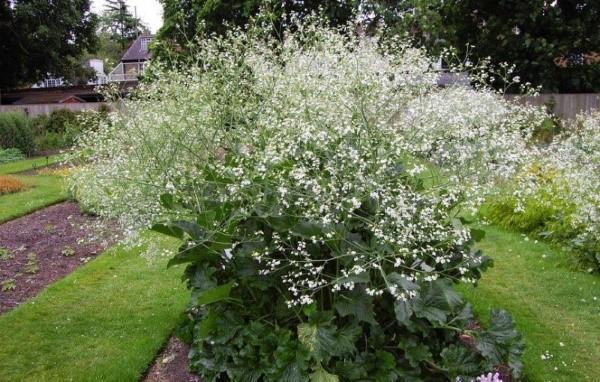We grow the Crimean steppe horseradish or katran
 The once juicy roots of the katran could be found in abundance in the Crimean steppes, for which it got its name. Today, the Crimean steppe horseradish has firmly taken its place in our beds. Being a separate culture, katran at the same time is the "brother" of horseradish. Both plants belong to the cruciferous family and will delight you with thick, edible and healthy roots. But they also have significant differences, both in appearance and in growing technology.
The once juicy roots of the katran could be found in abundance in the Crimean steppes, for which it got its name. Today, the Crimean steppe horseradish has firmly taken its place in our beds. Being a separate culture, katran at the same time is the "brother" of horseradish. Both plants belong to the cruciferous family and will delight you with thick, edible and healthy roots. But they also have significant differences, both in appearance and in growing technology.
What is the difference between katran and horseradish
Under natural conditions, katran is a perennial plant, but cultivated as a biennial. During the first year, it forms a large rosette of large, wide leaves. Their height can reach 120 cm. In the second year, it produces a branched stem, even higher, and blooms. Flowering begins in early summer and lasts about 2 months. The flowers are small, white, but collected in large brushes. The root system of the katran is a long taproot, juicy and fleshy. The creamy pulp tastes like horseradish.
Due to the sweet aroma of inflorescences, katran is excellent honey plant.
Despite the fact that katran and horseradish are in many ways similar to each other, the former has many more advantages.
Most gardeners prefer to grow katran because it:
- Does not turn into a weed that cannot be removed from the garden. The remaining pieces of roots die after digging, not giving young growth.
- Gives a greater harvest. In just the first year, the root of the katran grows up to 60 cm in length and 5 cm in diameter. Shitty roots develop at a slow pace.
- More juicy (meaning the roots themselves).
- Universal use. The roots can be baked or boiled, and the young foliage can be added to salads.
- Acts as a decorative culture. Although tall, the shriveled leaves are very beautiful and the flowering is long and fragrant.
Crimean steppe horseradish - katran: cultivation features
Katran is planted with seeds directly into open ground. This can be done before winter or spring. For spring planting, seeds need stratification, since they have a dense shell. To plant a katran, it is necessary to take a bright place with light fertile soil.
If desired, you can grow katran through seedlings by sowing seeds in March. However, in this case, it is important not to miss the moment of transplantation, until the pivotal root becomes too long.
Caring for the Crimean steppe horseradish in general is not particularly laborious, namely:
- When the seedlings grow up, they need to be thinned out, leaving at least 50 cm between the bushes. This is enough for the first year, and at the end of the season it will be possible to dig out some of the plants that thicken the plantings. By this time, they have already formed a fairly thick young root, suitable for consumption.
- Weed regularly and carefully loosen the row spacings.
- Watering is carried out as needed, preventing the soil from drying out.
- On poor soil during the season, you can feed the katran three times. After the first thinning - with ammonium nitrate, after 2 weeks - add potassium salt to it. Make the last dressing during flowering.
If the katran is not dug for the sake of the root, then it can grow in one place for up to 15 years. However, most often the harvest of juicy roots is harvested for 2 years of cultivation, digging them up in October-November.